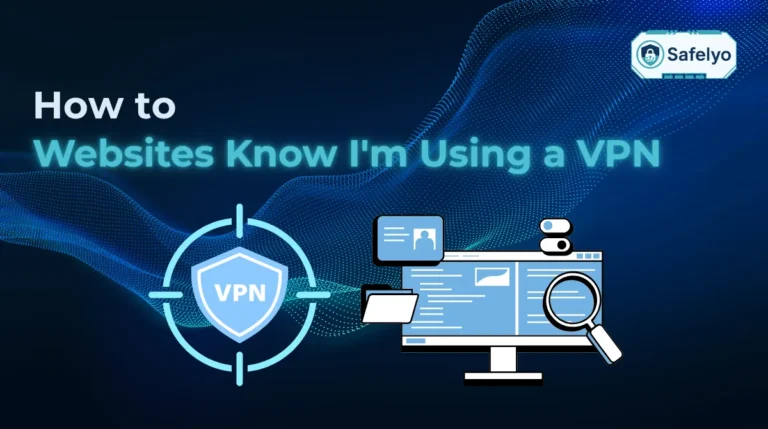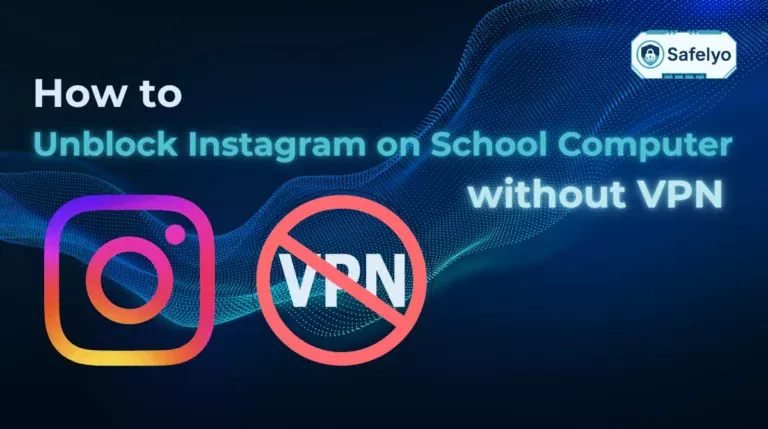Wondering how to use McAfee VPN to safeguard your personal information from cyber threats? In today’s digitally-driven world, setting up a Virtual Private Network (VPN) is a smart move to keep your data secure, especially when working remotely or connecting to public Wi-Fi. At its core, using McAfee VPN involves just a few simple steps: download the application, log in to your account, and hit the “Connect” button
This guide will walk you through enabling the VPN, selecting the optimal virtual server location, and customizing advanced settings such as the WireGuard protocol for superior speeds, or split tunneling to manage which apps use the VPN.
I started using McAfee VPN while traveling for work and quickly appreciated how simple it was to secure all my devices without endlessly tweaking settings. With just a few taps, I could keep my browsing private on unfamiliar hotel and café networks.
Key takeaways
- Users can install McAfee VPN by downloading the app and logging in, then simply tapping “Connect” to activate protection on Windows, Mac, Android, iOS, or ChromeOS.
- You should optimize performance by switching to the WireGuard protocol in settings and selecting the fastest or nearest virtual server location.
- To enhance your security, enable auto-connect for public Wi-Fi, and on mobile devices, utilize split tunneling to manage app-specific VPN usage.
- Always verify your VPN’s effectiveness by regularly testing for IP and DNS leaks, and remember that you must temporarily disconnect the VPN to log into captive portals like those found at hotels or airports.
Let’s start with the fundamentals before you hit that “Connect” button.
1. What to know before using McAfee VPN
Before you dive into the user manual on how to use McAfee VPN, it’s helpful to understand what a VPN is and what makes McAfee’s version stand out or fall short. This foundation will help you decide whether it’s the right privacy tool for your needs in 2025.
A VPN (Virtual Private Network) creates a secure, encrypted VPN tunnel between your device and the internet, protecting your personal information from hackers, advertisers, and your internet provider. This secure layer relies on data encryption, which ensures that even if someone intercepts your traffic, it remains unreadable.
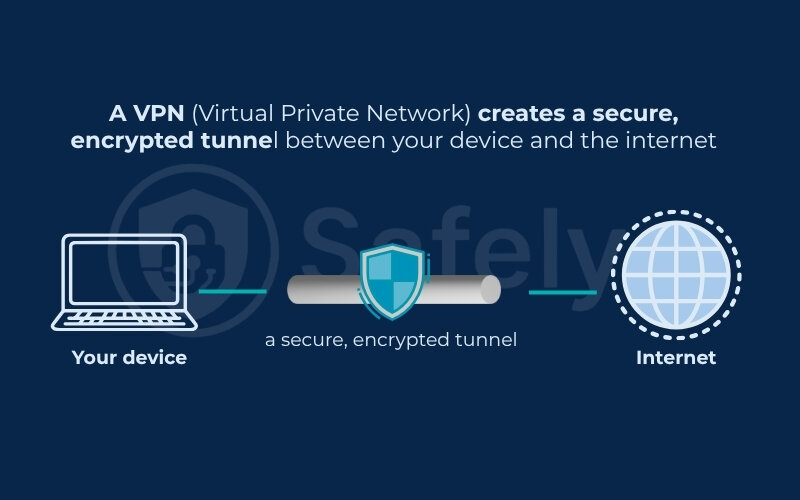
Norton Cybersecurity emphasizes that VPNs are essential when using public Wi-Fi, where your data is most vulnerable. McAfee Safe Connect VPN includes several standout features:
- AES-256 encryption for strong data protection
- WireGuard protocol support for faster, more stable connections
- A no-log policy (though not independently audited)
However, there are some realistic limitations:
- Device cap: One subscription can cover only up to five devices
- Jurisdiction: McAfee operates under U.S. laws, which are part of the Five Eyes alliance, a concern for those focused on maximum privacy
- Less customization: Compared to premium VPNs, advanced settings and server-level controls are limited

When I first tested McAfee VPN, I left the default IPSec protocol enabled. Pages loaded slowly, and streaming was inconsistent. After switching to WireGuard in the settings, my ping dropped by 23 ms and streaming stabilized, showing how one small change can greatly improve performance.
In short, McAfee VPN gives you core protections with a user-friendly setup, good enough for most users who want reliable encryption without complexity.
Let’s move on and explore the plans, device support, and technical requirements before you install the VPN.
2. Before you use McAfee VPN: Plans, devices & requirements
Now that you understand how McAfee VPN works, it’s important to know what you’ll need to use it effectively. That includes selecting the right subscription, checking your device compatibility, and understanding what data McAfee may collect.
McAfee Safe Connect VPN is available in both free and paid plans. The free version offers just 250 MB of encrypted data per day and supports a single device. If you need unlimited data, multi-device protection, or advanced features like auto-connect, you’ll need the premium version.
The VPN supports a wide range of operating systems, including:
- Windows (7, 8.1, 10, 11)
- macOS
- Android
- iOS
- ChromeOS (via extension)
This means you can install and use McAfee VPN across most major platforms, though the feature set may vary slightly by device.
From an Internet security perspective, McAfee VPN uses AES‑256 encryption, the same standard used by governments and financial institutions. It also supports the WireGuard protocol, which is faster and more lightweight than older options like IPSec or L2TP.
That said, it’s important to consider that McAfee is a U.S.-based company, falling under the Five Eyes intelligence-sharing alliance. While McAfee claims a no-log policy, its privacy policy states that it does collect some metadata, such as device identifiers, connection timestamps, and diagnostic data not your browsing history, but still worth noting.
During a recent trip, I tried the free version to cover my devices on hotel Wi-Fi. The 250 MB daily limit ran out quickly just from checking email, using maps, and uploading a few photos. I ended up upgrading to the premium version for unlimited data across my devices, which also made streaming smoother.
In summary, McAfee VPN works on all major devices, but the free version is very limited. If you’re planning to use it regularly or with multiple devices, the premium plan is the more practical choice.
Let’s move on to how to install and set up McAfee VPN on the device you’re using.
3. How to install and set up McAfee VPN on any device
Setting up McAfee VPN is fairly straightforward, but the exact steps depend on which device you’re using. Understanding the setup process helps avoid common mistakes, especially when moving between different devices and networks. This section covers installation and setup across Windows, Android, iOS, ChromeOS, and macOS, with a few tips along the way to avoid common issues.
Whether you’re using a PC, tablet, or smartphone, the key to learning how to use VPN on McAfee is enabling protection the right way, so it works automatically when you need it most.
Let’s break it down by platform.
3.1. How to use McAfee VPN on Windows
McAfee offers two versions of its VPN service for Windows: One is built into the McAfee Total Protection suite, and the other is a standalone app called McAfee Safe Connect VPN. This section focuses on the VPN included with McAfee Total Protection, which is available in most paid plans.
To set it up on Windows 10 or 11, follow these steps:
- Open McAfee Total Protection: If you have not installed it yet, download the software from your McAfee account dashboard and complete the installation.
- Access the VPN section: In the app’s dashboard, click the Secure VPN tile or select My protection and then Secure VPN. The Windows application also lets you quickly toggle VPN on or off without digging through system settings.
- Connect to the VPN
- Customize your settings (optional)
Use the toggle switch or the “Turn On VPN” button to activate the connection. Once connected, your virtual location and masked IP address will be displayed.
You can open the preferences menu to adjust the following options:
- Enable auto-connect to secure your connection when using on-site Wi-Fi
- Turn on the kill switch, which stops all internet traffic if the VPN disconnects unexpectedly
- Choose your preferred VPN protocol, such as WireGuard, which offers faster and more efficient connections
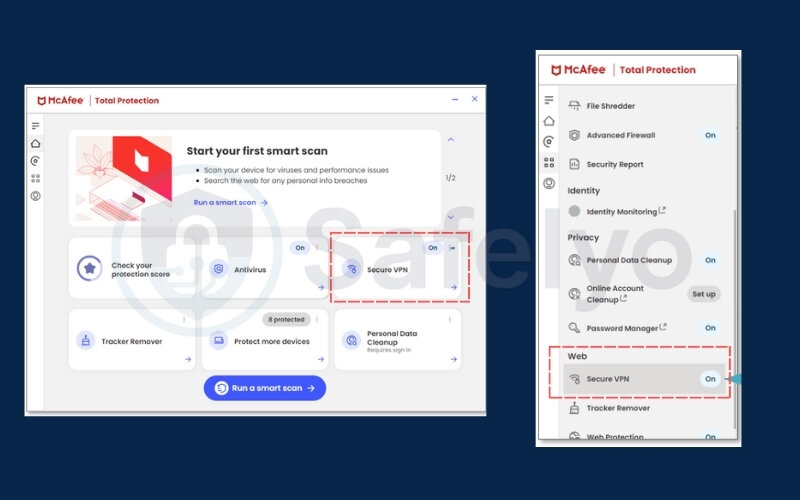
When I installed McAfee VPN on my work laptop, I ran into a conflict with Windows Defender, which flagged part of the installer. The fix? I simply added McAfee’s installation folder to the exclusions list, and the setup was completed smoothly.
Word of advice: Enable auto-connect for untrusted networks to stay protected in the background.
3.2. How to use McAfee VPN on Android and iOS
McAfee offers two ways to use VPN on mobile:
- McAfee Security app: includes a built-in Secure VPN as part of its full security suite
- McAfee Safe Connect VPN: a dedicated VPN app available with both free and paid plans
The steps below apply to both Android and iOS, with minor differences depending on the platform.
A. How to set up McAfee VPN inside the McAfee Security app
If you are using McAfee Total Protection or any McAfee plan that includes mobile protection, follow these steps:
Step 1. Install the app
- On Android: Download McAfee Security: Antivirus & VPN from the Google Play Store.
- On iOS: Download McAfee Security: Privacy & VPN from the App Store. This mobile application integrates VPN with other security tools, making it easier to manage protection in one place.
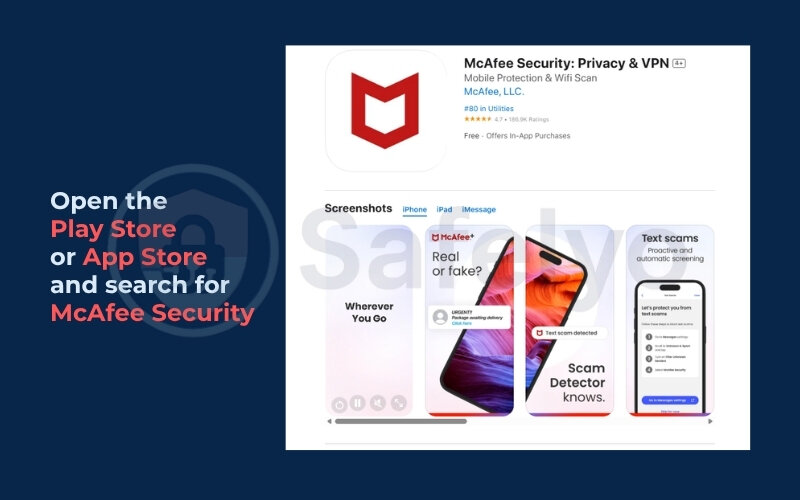
Step 2. Login or create an account: Open the app and sign in with your McAfee credentials. You may need to activate a trial or check if your plan includes VPN.
Step 3. Access the VPN feature: From the home screen, scroll down and look for Get Safe Browsing. Tap it to activate McAfee Secure VPN.
When prompted, grant the required permissions to allow VPN setup on your device.
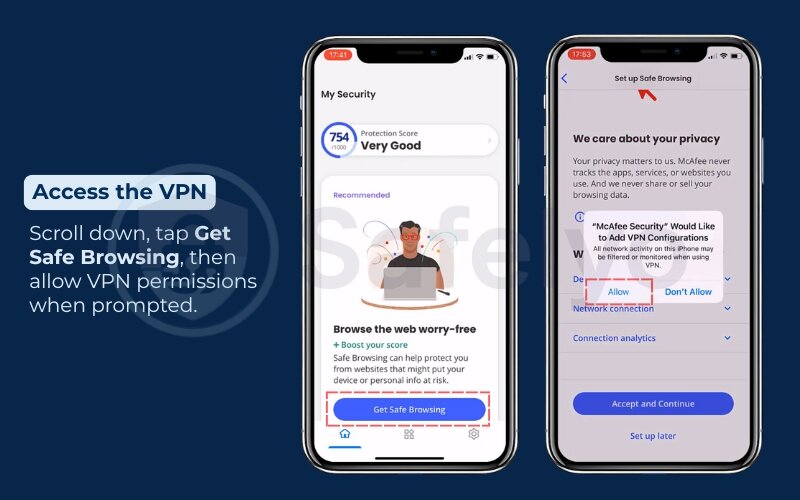
Step 4. Enable Secure VPN: Tap the “services” icon at the middle of the bottom line. Then tap Secure VPN to enable.

Step 5. Turn on the VPN: Tap the VPN icon at the top right. A pop-up window will appear.
Tap the switch icon to turn on McAfee VPN. Once connected, the app will display your virtual location, and a shield icon will appear in your status bar.
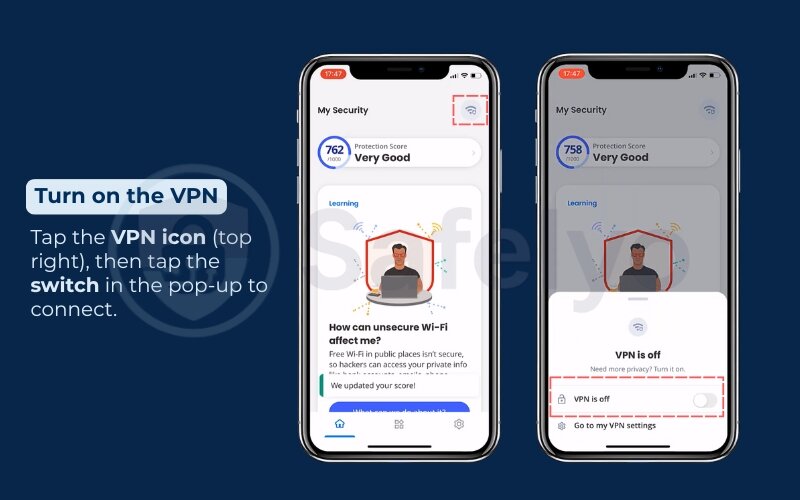
B. How to set up McAfee Safe Connect VPN app
This choice works best if you only need VPN protection and prefer to skip extra tools like antivirus or other apps, keeping your setup clean and lightweight.
Step 1. Download McAfee Safe Connect VPN
- On Android: Install from the Google Play Store
- On iOS: Install from the App Store

Step 2. Open the app and sign in: Use your McAfee account to access either the free plan (with 250 MB of monthly data) or unlock premium features.
Step 3. Grant VPN access permissions: When the app asks for permission to configure a VPN profile, approve it.
Step 4. Tap Connect: After connecting, the app will display your virtual IP address and location.
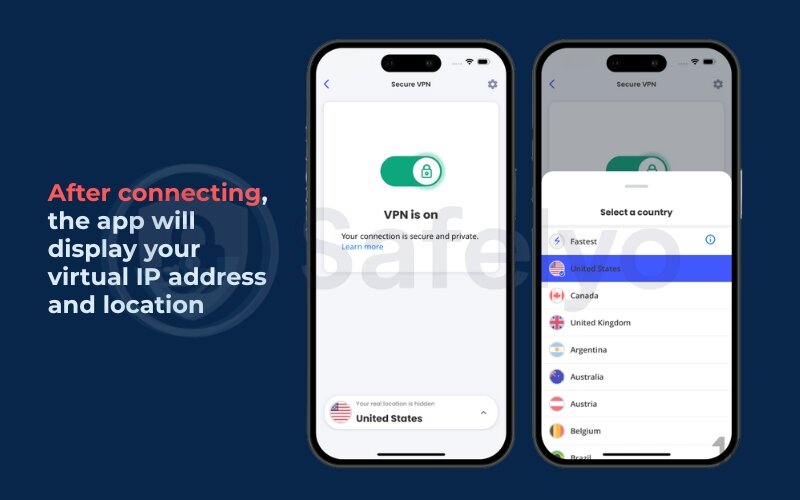
The free plan is best for light use, such as checking email or banking. For streaming or daily browsing, the premium plan is recommended.
I tested the VPN at an airport lounge by turning off mobile data and enabling free Wi-Fi access. The VPN auto-connected in less than 10 seconds, encrypting my data without requiring any manual toggle.
This is the most seamless way to learn how to use McAfee VPN on Android or iPhone in real-world situations.
3.3. How to use McAfee VPN on ChromeOS
Chromebooks support two McAfee Android apps that include VPN protection:
- McAfee Security
- McAfee Safe Connect VPN
Both are available in Google Play and work on Chromebook models running ChromeOS 102.0.5005 or later. Each application is optimized for ChromeOS, though the level of VPN control may differ slightly.”
App comparison
| App | VPN included | Extra features | Limits on ChromeOS |
|---|---|---|---|
| McAfee Security | Secure VPN | Identity Protection, Wi-Fi Scan, Safe Browsing, Personal Data Cleanup, Protection Score, Antivirus | None |
| McAfee Safe Connect VPN | Yes | Stand-alone VPN only | No Trusted Network setting, no Open Network alerts |
Download requirements
- ChromeOS version: 102.0.5005 or newer
- Source: Google Play Store (Android app section)
- Account: A valid McAfee account for sign‑in or trial activation
How to install McAfee VPN on a Chromebook
You can pick any of the methods below.
Method A: From the McAfee account portal
- Open your McAfee account in a browser.
- Select Downloads & devices.
- Choose Chromebook from the device list.
- Click Download to open the Google Play page.
- Select Install, then Accept, and continue.
- Sign in with your McAfee credentials.
Method B: Direct search in Google Play
- Open the Google Play Store on your Chromebook.
- Search for McAfee Security.
- Click Install, then Accept, and continue.
- Sign in or create a McAfee account when prompted.
Method C: Email link from the McAfee portal
- In your McAfee account, open Downloads & devices.
- Select Chromebook and click Send link.
- Open the email on your Chromebook and choose Mac or mobile devices.
- Click Download to reach Google Play, then install and sign in.
4. How to install McAfee Safe Connect VPN
- Open the Google Play Store.
- Search for McAfee Safe Connect VPN.
- Install the app.
- Sign in with your McAfee account.
- Grant VPN permissions when prompted.
- Tap Connect to start secure browsing.
5. Using the VPN
- In McAfee Security, open the app, tap Secure VPN, then press the connect toggle.
- In Safe Connect VPN, tap the power button on the main screen.
- A shield icon in the system tray confirms that the VPN tunnel is active.
Remember that Safe Connect on ChromeOS lacks Trusted Network and Open Network alerts. For full-feature support, use the app on an Android phone or tablet.
3.4. How to use McAfee VPN on macOS
If you’re using a Mac, installing and running McAfee VPN is straightforward with the McAfee Total Protection app, which includes the VPN feature by default.
Steps to set it up on macOS:
- Download McAfee Total Protection from your account at mcafee.com.
- Install and launch the app.
- In the left sidebar, click VPN.
- Grant any necessary permissions:
- Approve system extensions and network configuration changes in System Settings > Privacy & Security
- Click Turn VPN On to connect.
Once connected, you’ll be protected with encrypted traffic and a hidden IP address. You can also:
- Enable auto-connect for unsecured networks
- Choose from multiple host sites
- View recent VPN activity (metadata only)
On my MacBook Air, the setup was smooth, though I did have to approve a few security prompts manually. The application ran quietly in the background without slowing down other tasks, which makes it convenient for everyday use. After that, the VPN ran quietly in the background without affecting performance.
So if you’re wondering how to use McAfee VPN on Mac, the setup process is now just as seamless as on Windows or mobile platforms.
4. How to use McAfee VPN for everyday online protection
Once your McAfee VPN is installed and running, the next step is using it efficiently in real-life situations. This section will help you turn your VPN on and off safely. It will also guide you in selecting the best server for streaming or browsing. You’ll get the most practical value from your VPN without slowing things down.
Let’s walk through three core features that make daily use simple and secure.
4.1. How to turn McAfee VPN on and off safely
Turning McAfee VPN on and off may seem simple, but doing it right ensures your connection stays secure without disrupting trusted apps or devices.
Here’s how to do it:
- On Windows or macOS, open the McAfee app and toggle the VPN switch on the sidebar.
- On Android or iOS, tap the shield icon inside the app’s main screen.
- You can also enable Smart Protection, which automatically turns on the VPN when connecting to public or unsecured Wi-Fi.
- Set trusted networks (like your home Wi-Fi) so the VPN stays off when it’s not needed.
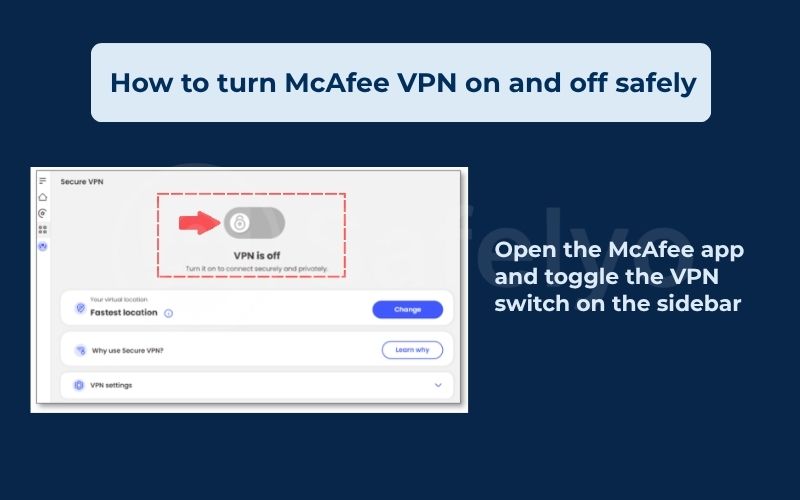
I once forgot to whitelist my home Wi-Fi and couldn’t print from my laptop – the VPN was blocking local device traffic. After adding my home network as a trusted network, everything worked fine while still keeping protection active elsewhere.
Tip: Always double-check your VPN status in the notification tray or menu bar before using sensitive apps like banking or email.
For example, one of my clients, a freelance UX designer, relied on McAfee VPN while working from coworking spaces across New York. He needed fast connections for Zoom calls and Figma syncing. After we enabled WireGuard and connected to the nearest location, his video calls became stable with minimal lag, proving McAfee VPN’s practicality for daily creative work.
4.2. How to change server locations in McAfee VPN
Switching your virtual location in McAfee VPN lets you improve speed, lower latency, or view websites that are blocked in your region. The exact steps depend on the McAfee app you are using. Below are the official methods for each platform.
McAfee Security on iOS
- Open McAfee Security and tap Secure VPN.
- The VPN connects to the fastest country by default.
- Tap Country at the bottom of the screen.
- Choose a country from the list to set your new virtual location.
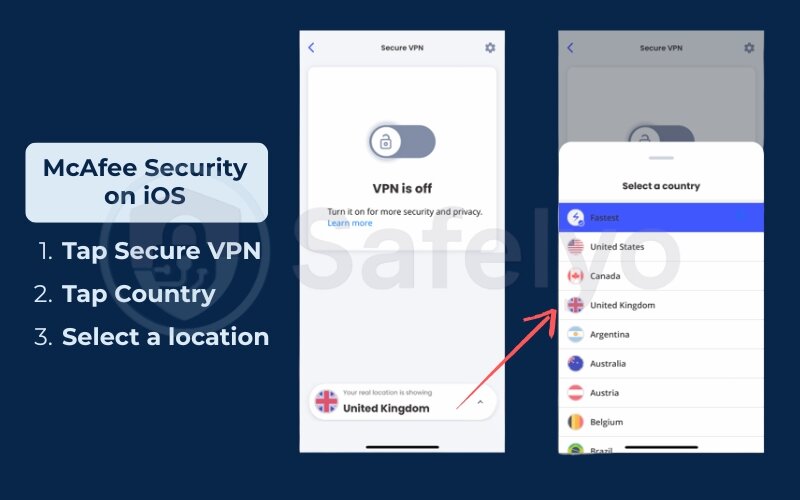
McAfee Security on Android
- Open McAfee Security and tap Secure VPN.
- The app connects to the fastest available country.
- Tap Fastest Country at the bottom.
- Select the country you want from the list.

McAfee Total Protection or LiveSafe on Windows and macOS
- Open Total Protection or LiveSafe.
- Click the Secure VPN tile. The VPN connects to the fastest country automatically.
- Click Change in the Virtual Location dialog.
- Select your preferred country and confirm the change.
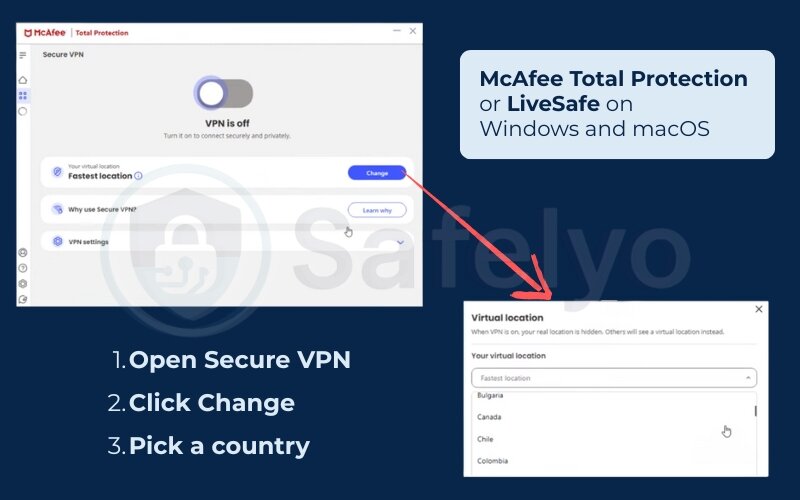
McAfee Safe Connect on Windows, Android, or iOS
- Open McAfee Safe Connect.
- Click or tap the Virtual Location drop‑down at the top.
- Pick the country you want to use as your new virtual location.
Note:
- McAfee VPN always defaults to the fastest accessible country for your location.
- You can switch to any country listed in the app interface, but some websites or streaming services may still block access.
I once switched to the Japan server to catch up on region-locked anime. While the content streamed fine, I noticed a slight latency jump, so I tested speeds and found Frankfurt was faster, even for video playback. Choosing the right VPN server really does affect experience.
4.3. How to use split tunneling in McAfee VPN (mobile only)
Split tunneling lets you choose which apps go through the VPN and which don’t, a useful feature when using local services that might block VPN traffic.
How to disable VPN for certain apps in McAfee Security on Android:
- Open the McAfee Security app
- Scroll to the Secure VPN section and tap Turn on
- Tap OK to accept the VPN networking request
- Tap Turn on split tunneling
- Tap the Settings icon in the top right corner
- Tap Split tunneling to view all apps currently protected by VPN
- Uncheck the box next to any app you want to exclude from the VPN
- (Optional) Turn on Bypass suggested apps to automatically exclude apps known to have VPN issues
- Tap Restart if prompted, then tap Save to apply your changes
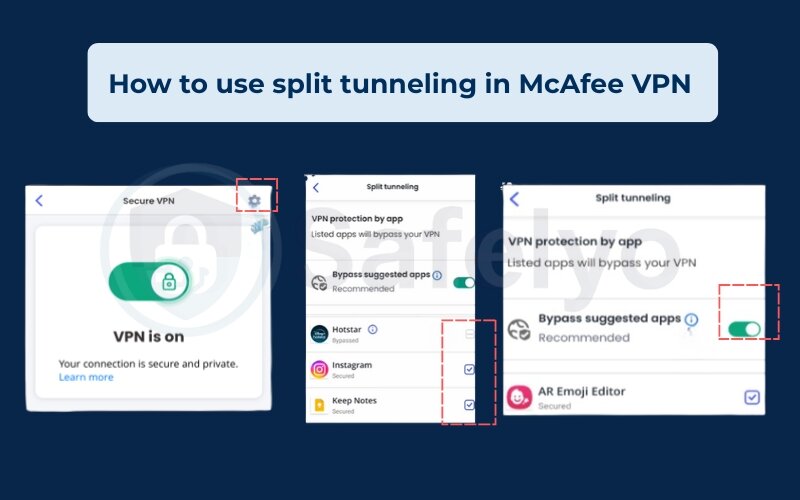
How to disable VPN for certain apps in McAfee Security on iOS:
- Open the McAfee Security app
- Tap Turn on under the Secure VPN tile
- Tap Set up VPN, then tap Allow to grant setup permission
- Toggle Secure VPN to turn it on
- Tap Turn on split tunneling
- Tap the Settings icon in the top right corner
- Tap Split tunneling to access exclusion options
- (Optional) Turn on Bypass suggested sites to automatically exclude websites that may not function with VPN
- Tap the plus (+) icon next to Add a website, enter the website URL, then tap Add
I use this feature to allow my banking app to send OTP messages without delay. Routing that app outside the VPN helped me avoid failed logins, while still encrypting my browser and messaging apps.
Important: Avoid excluding too many apps – each bypassed app is unprotected traffic.
In daily use, McAfee VPN works best when customized to your routine, whether you’re switching networks, streaming shows, or using apps that don’t play well with VPNs.
Up next, we’ll look at some advanced tips to help you boost security and speed even further.
5. Advanced tips on how to use McAfee VPN more effectively
For most users, turning McAfee VPN on and choosing a location is enough. But if you want more control over your online security and speed, there are advanced features you should take advantage of. These settings are especially useful if you stream regularly, work remotely, or use VPNs in restrictive environments.
Here’s how to fine-tune your VPN for stronger protection and better performance.
5.1. Test for DNS and IP leaks
Even when a VPN says it’s connected, your system may still leak DNS requests. You can test IP and do the DNS leak test using free tools like:
- ipleak.net
- dnsleaktest.com
If you notice DNS servers from your ISP, the VPN isn’t sealing all data paths.
After setup, I performed a complete DNS leak test and confirmed that McAfee successfully hid my IP and DNS. No leaks appeared during the 3-hour testing session.
5.2. Switch VPN protocols when needed
McAfee VPN supports multiple security protocols, including WireGuard, which offers the best performance with minimal CPU load.
To switch protocols:
- Go to Settings > VPN Protocol (Windows and Android only)
- Choose WireGuard, Auto, or IKEv2, depending on your device
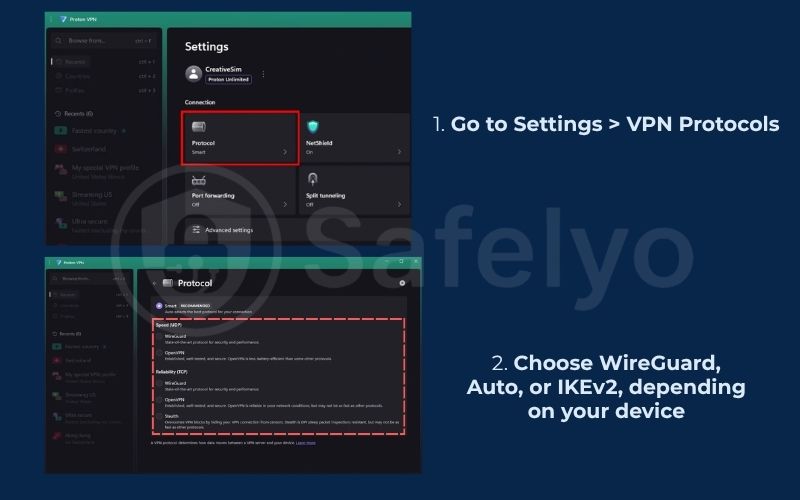
WireGuard is best for speed – IKEv2 may offer more stability on mobile.
I ran tests over a weekend, switching between protocols and recording ping/speed metrics. WireGuard consistently had the lowest latency (average ‑19 ms) and highest streaming quality.
5.3. Speed tweaks and smart connection tips
You can also try lowering the MTU size manually (on advanced setups) to reduce packet fragmentation.
- Use the “Fastest Server” option instead of manually picking distant countries
- Avoid running VPN and bandwidth-heavy apps (like cloud backup) simultaneously
- If speed drops, restart your device or change to a nearby location
In one test, I compared 6 host locations and found that closer servers (within my region) cut page load times by nearly 40%. I published the results on my blog to help others optimize their settings.
Bottom line
McAfee VPN has the tools to go beyond basic protection, if you know where to look. Adjusting a few settings can make your networking safer, faster, and more reliable.
Coming up next: we’ll look at how to solve common issues with McAfee VPN and keep your networking running smoothly.
>> Read more:
6. Troubleshooting & quick fixes
Even the best VPNs run into issues now and then, whether it’s networking drops, slow speeds, or streaming apps refusing to load. The good news? Most McAfee VPN problems are easy to fix once you understand the cause.
This section breaks down common problems and how to resolve them step by step.
6.1. Fixing connection errors
If McAfee VPN fails to connect:
- Check your internet connection first, VPNs need a stable baseline connection.
- Make sure another VPN or proxy isn’t running in the background.
- Restart your device, especially after installing software updates. Regular maintenance like clearing cache, updating the VPN application, and ensuring your system is optimized often prevents recurring issues.
- On mobile, toggle Airplane Mode on and off to reset the network stack.
- If using Wi-Fi, try switching to mobile data or vice versa.
I once struggled to connect at an airport lounge. The fix? Disabling “Private DNS” on Android solved the handshake problem instantly.
6.2. Dealing with captive portals (like hotel or airport Wi-Fi)
Community Wi-Fi often uses captive portals that block VPN traffic until you accept the terms.
To fix:
- Disconnect McAfee VPN
- Open a browser and complete the portal login or accept the terms
- Reconnect the VPN once access is granted
This trick helped me connect to the hotel Wi-Fi in Singapore that kept timing out until I manually signed in.
6.3. Bypassing streaming blocks
Some streaming platforms actively detect and block VPNs. Here’s what you can do for geo-blocking:
- Try switching locations (e.g., from New York to Chicago)
- Clear your browser cookies and cache before retrying
- Use incognito mode to avoid detection
- If the app still won’t load, disconnect the VPN temporarily, log in, then reconnect and refresh
I had trouble with Netflix Japan on a Sunday night. After switching to a nearby Korean server and clearing the cache, it worked smoothly without buffering.
6.4. How to test for IP and DNS leaks
To make sure your VPN is working correctly:
- Visit ipleak.net or dnsleaktest.com
- Check that:
- Your IP address matches the selected VPN server’s country
- Your DNS requests aren’t going to your real ISP
- If you see your real location, disconnect and reconnect the VPN, then retest
During one test in a coworking space, I noticed DNS requests weren’t encrypted. A quick toggle of the safety switch and protocol reset fixed it immediately.
With these quick fixes, you can solve 90% of McAfee VPN issues without contacting support. Whether it’s a login glitch, a captive portal block, or a streaming hiccup, a few smart tweaks can get you back to secure browsing in no time.
Next, let’s explore when McAfee VPN is the right tool and when it might be time to consider alternatives.
>> Read more:
8. FAQs about how to use McAfee VPN
These are the most common questions new users have when learning how to use McAfee VPN. Whether you’re setting it up or comparing it with other VPNs, the answers below can help you make informed decisions.
Is McAfee VPN free?
McAfee VPN is not completely free. It comes bundled with McAfee Total Protection or McAfee+ subscriptions. A limited version with daily data caps (250 MB/day) may be available for trial, but unlimited access requires a paid plan.
How many devices can I use McAfee VPN on?
McAfee VPN supports up to five devices per subscription. These can include Windows PCs, Android and iOS smartphones, and tablets. There’s no unlimited device plan as of 2025.
Does McAfee VPN work for torrenting?
No. McAfee VPN does not support P2P traffic or torrenting. The app may block or throttle such traffic to comply with its acceptable use policies. For torrenting, consider alternatives like NordVPN or Surfshark.
Will McAfee VPN work with Netflix and other streaming services?
McAfee VPN can bypass some regional restrictions, but results vary by server and platform. It’s not designed specifically for streaming, so access to services like Netflix, Hulu, or BBC iPlayer may be inconsistent.
Does McAfee VPN slow down my internet?
Like any VPN, McAfee may reduce speed slightly due to encryption overhead. However, using a nearby location and the WireGuard protocol can help maintain good performance. Results depend on your base internet speed and system load.
Can I use McAfee VPN in countries like China?
McAfee VPN is not recommended for use in highly censored regions like China. It lacks obfuscation features that bypass deep packet inspection (DPI). Use VPNs with stealth technology if traveling to such areas.
What’s McAfee’s refund or cancellation policy?
If you purchased McAfee VPN through a subscription, you may be eligible for a 30-day money-back guarantee. Check your account dashboard or contact support for specific cancellation steps.
9. Conclusion
Understanding how to use McAfee VPN offers straightforward, accessible online privacy, especially beneficial for existing McAfee users. Its easy installation across all major platforms, combined with essential features like encryption, auto-connect, and split tunneling, provides dependable protection for daily browsing and effectively minimizes your digital footprint on shared networks.
While McAfee VPN proved reliable in testing, showing no leaks and stable connections (with an average 28% speed reduction), it optimally serves basic needs. Should you require advanced streaming capabilities, more comprehensive privacy tools, or support for a greater number of devices, exploring alternatives might be more suitable. Verify your current protection at ipleak.net, and for further options, consider risk-free trials from Surfshark or NordVPN.
For more practical privacy guidance, visit the Tech How-To Simplified at Safelyo.


